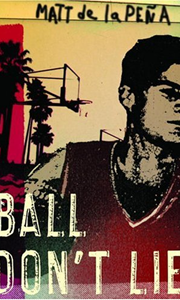I read...A few years ago [a lot more than a few years ago now] I got the chance to meet agent Nathan Bransford at a local SCBWI conference. He critiqued the first five pages of my first novel. The two pieces of feedback he gave me? “A lot of novels start this way.” (One character upstairs, another downstairs, calling to each other.) And, “You don’t have a unique voice.” Ouch. I thanked him and left. My 15 minutes were up. I spent the second half of the day mooning about and then—if you’ll excuse the decidedly non-feminine expression—manned up and marched over to where Nathan was waiting all by himself and asked if he could recommend any books I should read that had a good strong voice. He did. Ball Don’t Lie was one of them. And I learned...Ta da! Voice! Voice is the magic of a book. No voice and you’re likely to get a form rejection. Every agent and editor (and reader!) is looking for “fresh new voices.” Trouble is, voice is also nebulous, hard to describe, harder to teach, but oh-so-obvious when you read it. Voice is a concatenation of writerly skills, techniques, and just plain individual style. Voice is limitless. Voice is not simply point of view, tho I have heard some authors call it that. Point of view is fairly limited: 1st person, 2nd person, 3rd person; limited or omniscient. POV is a part of voice, but not the whole of voice. de la Pena uses an external first-person narrator to tell an omniscient third-person story about Sticky, the main character: I could tell you a lot about this game… (says the narrator) Oh, that name, the lady said in a voice so Sticky couldn’t hear. She moved under the game room door frame. We’ll have to do something about that awful name. Voice includes using slang or swear words, whatever words your characters may use. In the right novel, voice can include dusting off your SAT vocabulary and busting out with words like septuagenarian or apotheosis. de la Pena uses street slang to describe street basketball: It’s tied sevens and Sticky’s handling the rock up top. Back and forth with the left hand. In front of his glazed body. Rhythm pats. Type of dribbles that get you in the groove to cut and slash, body loose and quick to make somebody look like a fool. The ball is also called a “brick.” The hoop a “bucket.” Men are called “cats” and “fellas” and “guys.” Girlfriends are called “old ladies.” Voice includes how you write description: as solid blocks of fragmentary sentences or long, flowing, lyrical sentences. de la Pena does things a little differently by using a colon to set off phrases of description: Jimmy is: eyes the size of golf balls in thick Coke-bottle glasses, overgrown crop that starts a thumb’s width from his bushy eyebrows, old beat-up flea-bitten sweatshirt zipped up to the throat: ARMY FOOTBALL. Voice can include repeating phrases over and over to indicate a character’s personality: Sticky shook her off. Pulled out one pair [of pants], checked tangs twice (price and size) and then stuck them back on the rack. When the sticking-back sound didn’t sound right, he pulled them off and stuck them back again. Pulled them off and stuck them back. He started to panic inside. Started sweating. Last thing he wanted to do in front of this pretty girl was act all retarded. But he couldn’t stop himself. He pulled them off and stuck them back again. (Note the use of the word retarded in that quote. Many people won't use it, so its use here is part of voice and part of character development.) Voice can include formatting, like using italics for dialog: Oh, damn, that was a nasty foul, Dave said, holding a fist to his mouth. Jay had to slap em down, though, Sticky said. He had to let em know whose lane it was. Fat Jay did just like this, Sin said, and he put his arm out clothesline style and swung it through the air. That’s the kinda foul that could set the tone. Like Sticky said. After Fat Jay did that, wasn’t no little number twenty-three flyin through the lane no more, right? Voice is all of these things. And a little bit more. Voice combines to create a story that could only be about Sticky, only be written by Matt de la Pena. You could pick this book up and read a few lines and know it wasn’t written by Suzanne Collins or Meg Cabot or even Chris Crutcher, another YA-boys-sports-issues book writer. TL;DRVoice is a unique blending of all these tools: POV, verb tense, word choice (which includes formal vs slang, in addition to individual words), metaphors, how you handle description, even formatting. It happens through writing over and over and over again. Every day. Pruning out that which doesn’t fit, allowing to grow that which does. Voice is developed over time and with much practice of the basic skills in a writer’s toolbox. Voice truly is more than the sum of its parts. Read 1000 booksReading widely changes your writing. For the better. Many published writers credit their success to having read voraciously, both in and out of their chosen genres. But most people don't read like editors; they read for enjoyment, not to learn a new writing technique. I read for a zillion reasons, and one IS to learn writing and story-telling techniques. Occasionally, I'll write about what I learn and share it with you here. Read 1000 books. Then write one. A little backgroundI first wrote this piece approximately a thousand years ago (or nine. Nine years ago) and posted it to my blog, but that blog has since disappeared into the ether. So, here it is again. Related articles
0 Comments
Leave a Reply. |
About ValI read, and then I tell you about what I've read. Whether you want to hear about it or not... Categories
All
Archives
July 2019
|



 RSS Feed
RSS Feed
